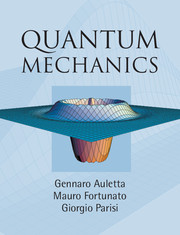Book contents
- Frontmatter
- Contents
- List of figures
- List of tables
- List of definitions, principles, etc.
- List of boxes
- List of symbols
- List of abbreviations
- Introduction
- Part I Basic features of quantum mechanics
- 1 From classical mechanics to quantum mechanics
- 2 Quantum observables and states
- 3 Quantum dynamics
- 4 Examples of quantum dynamics
- 5 Density matrix
- Part II More advanced topics
- Part III Matter and light
- Part IV Quantum information: state and correlations
- Bibliography
- Author index
- Subject index
4 - Examples of quantum dynamics
Published online by Cambridge University Press: 05 June 2012
- Frontmatter
- Contents
- List of figures
- List of tables
- List of definitions, principles, etc.
- List of boxes
- List of symbols
- List of abbreviations
- Introduction
- Part I Basic features of quantum mechanics
- 1 From classical mechanics to quantum mechanics
- 2 Quantum observables and states
- 3 Quantum dynamics
- 4 Examples of quantum dynamics
- 5 Density matrix
- Part II More advanced topics
- Part III Matter and light
- Part IV Quantum information: state and correlations
- Bibliography
- Author index
- Subject index
Summary
In this chapter we shall discuss some elementary examples of quantum dynamics. In Sec. 4.1 we shall go back to the problem of a particle in a box, this time with finite potential wells. In Sec. 4.2 we shall analyze the effects of a potential barrier on a moving particle. In Sec. 4.3 we shall consider another quantum effect which has no analogue in the classical domain: a quantum particle can tunnel in a classically forbidden region. In Sec. 4.4 perhaps the most important dynamical typology (with a wide range of applications) is considered: the harmonic oscillator. Finally, in Sec. 4.5 several types of elementary fields are considered.
Finite potential wells
In Sec. 3.4 we have considered what is perhaps the simplest example of quantum dynamics, that is a free particle moving in a box with infinite potential walls. Consider the motion of, say, a one-dimensional particle in a rectangular potential well with finite steps. In Fig. 4.1 we show two of such potentials, symmetric in (a) and asymmetric in (b).
Let us consider the case pictured in Fig. 4.1(a) and indicate with V0 the energy of the potential well. We may therefore distinguish three regions on the x-axis: region I (x < 0), where the potential energy is equal to V0; region II (0 ≤ x ≤ a), where the particle is free; and region III (x > a), where the potential energy is again equal to V0.
- Type
- Chapter
- Information
- Quantum Mechanics , pp. 141 - 173Publisher: Cambridge University PressPrint publication year: 2009



